This article's factual accuracy is disputed .(September 2016) |
The territorial evolution of the Ottoman Empire spans seven centuries.
This article's factual accuracy is disputed .(September 2016) |
The territorial evolution of the Ottoman Empire spans seven centuries.
The origins of the Ottomans can be traced back to the late 11th century when a few small Muslim emirates of Turkic origins and nomadic nature—called Beyliks—started to be found in different parts of Anatolia Their main role was to defend Seljuk border areas with the Byzantine Empire —a role reinforced by the migration of many Turks to Asia Minor. [1] However, in 1071 and following the victory of the Sultanate of Rum over the Byzantines at the Battle of Manzikert, Beyliks sought an opportunity to override the Seljuk authority and declare their own sovereignty openly.
While the Byzantine Empire was to continue for nearly another four centuries, and the Crusades would contest the issue for some time, the victory at Manzikert signalled the beginning of Turkic ascendancy in Anatolia. The subsequent weakening of the Byzantine Empire and the political rivalry between the Seljuk Sultanate of Rum and the Fatimids in Egypt and southern Syria were the main factors that helped the Beyliks take advantage of the situation and unite their principalities. [2]
Among those principalities was a tribe called Söğüt, founded and led by Ertuğrul, which settled in the river valley of Sakarya. When Ertuğrul died c. 1280 his son Osman succeeded him, establishing the state which would go on to become the Ottoman Empire.

Murad I (nicknamed Hüdavendigâr, from Persian: خداوندگار, Khodāvandgār, "the devotee of God" – but meaning "sovereign" in this context) (Turkish : I. Murat Hüdavendigâr) (March or June 29, 1326, Sogut or Bursa – June 28, 1389, Battle of Kosovo) (Ottoman Turkish : مراد الأول) was the ruler of the Ottoman Empire, Sultan of Rûm, from 1359 to 1389. He was the son of Orhan I and the Valide Sultan Nilüfer Hatun (whose name means Water lily in Turkish), daughter of the Prince of Yarhisar or Byzantine Princess Helen (also named Nilüfer), who was of ethnic Greek descent [3] [4] [5] and became the ruler following his father's death in 1359.
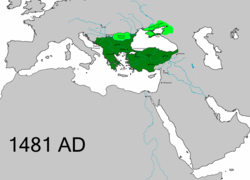
Mehmet II (Ottoman Turkish: محمد الثانى Meḥmed-i sānī, Turkish : II. Mehmet), (also known as el-Fatih (الفاتح), "the Conqueror", in Ottoman Turkish), or, in modern Turkish, Fatih Sultan Mehmet) (March 30, 1432, Edirne – May 3, 1481, Hünkârcayırı, near Gebze) was Sultan of the Ottoman Empire (Rûm until the conquest) for a short time from 1444 to September 1446, and later from February 1451 to 1481. At the age of 21, he conquered Constantinople (on Tuesday, 29 May 1453), bringing an end to the Byzantine Empire.
Selim I (Ottoman Turkish: سليم اوّل, Modern Turkish: I. Selim) also known as "the Grim" or "the Brave", or the best translation "the Stern", Yavuz in Turkish, the long name is Yavuz Sultan Selim; (1470/1 – September 22, 1520) was the Sultan of the Ottoman Empire from 1512 to 1520. [6]
Selim's father was Bayezid II and his mother was Ayşe Hatun, from Dulkadirids.
Selim carried the empire to the leadership of the Sunni branch of Islam by his conquest of the Middle East. He represents a sudden change in the expansion policy of the empire, which before his reign had mostly worked against the West and the Beyliks. [7] On the eve of his death in 1520, the Ottoman empire spanned almost 1,000 million acres (4,000,000 km2) (trebling during Selim's reign). These included some dependent, vassal states such as like Walachia from 1396, Crimea Khanate from 1475, Moldavia from 1501 and Algeria from 1520.

Suleiman I (Ottoman Turkish : سليمانSüleymān, Turkish : Süleyman; almost always Kanuni Sultan Süleyman) (6 November 1494 – 5/6/7 September 1566), was the tenth and longest-reigning Sultan of the Ottoman Empire, from 1520 to his death in 1566. Suleiman became a prominent monarch of 16th century Europe and personally led Ottoman armies to conquer Belgrade and Rhodes, as well as most of Hungary. In 1541 he annexed central Hungary and Transylvania became an Ottoman vassal. However, the rest of the Kingdom of Hungary, including western and northern (Upper) Hungary and Croatia, was still in Habsburg possession. Suleiman also conquered Iraq in his conflict with the Safavid dynasty. Under his rule, the Ottoman fleet dominated the seas from the Mediterranean to the Red Sea and the Persian Gulf. [8] Places which make up modern day Kuwait, Saudi Arabia and Qatar came under the control of the Ottomans.


The Treaty of Zohab (or the Treaty of Qasr-e-Shirin) was an accord signed between Safavid Persia and the Ottoman Empire on May 17, 1639. This accord ended the war that had begun in 1623 and was the last conflict in almost 150 years of intermittent wars between the two states over territorial disputes. The treaty divided territories in the Middle East by granting Yerevan in the southern Caucasus to Iran and all of Mesopotamia (including Baghdad) to the Ottomans.

In 1672 the Ottomans under Sultan Mehmed IV and Grand Vizier Fadil Ahmad Pasha conquered Podolia from the Polish–Lithuanian Commonwealth.
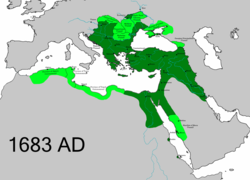
The Treaty of Bakhchisarai was signed in Bakhchisaray after the Russo-Turkish War (1676–1681) on January 3, 1681 by Russia, the Ottoman Empire, and the Crimean Khanate. They agreed to a 20-year truce and had accepted the Dnieper River as the demarcation line between the Ottoman Empire and Moscow's domain. All sides agreed not to settle the territory between the Southern Buh and Dnieper rivers. After the signing of the treaty, the Nogai hordes still retained the right to live as nomads in the southern steppes of Ukraine, while the Cossacks retained the right to fish in the Dnieper and its tributaries; to obtain salt in the south; and to sail on the Dnieper and the Black Sea. The sultan then recognized Muscovy's sovereignty in the Left-bank Ukraine region and the Zaporozhian Cossack domain, while the southern part of the Kiev region, the Bratslav region, and Podolia were left under Ottoman control. The 1683 battle of Vienna effectively ended Ottoman threats towards Central Europe, even though the empire remained strong in the Balkans for another hundred years. In the battle of Párkány the Ottoman lost the city of Esztergom.

The Treaty (Peace) of Karlowitz (Karlovci) was signed on January 26, 1699 in Sremski Karlovci (Serbian Cyrillic: Сремски Карловци, Croatian: Srijemski Karlovci, German: Karlowitz, Turkish: Karlofça, Hungarian: Karlóca), a town in modern-day Serbia, concluding the Austro-Ottoman War of 1683–1697 in which the Ottoman side had finally been defeated at the Battle of Zenta.
Following a two-month congress between the Ottoman Empire on one side and the Holy League of 1684, a coalition of various European powers including the Habsburg Monarchy, the Polish–Lithuanian Commonwealth, the Republic of Venice and Peter I's Alekseyevich (later known as The Great) Muscovite Russia, largely due to claims of being a self-professed defender of the Christian Slavs, a treaty was signed on January 26, 1699. The Ottomans ceded most of Hungary, Transylvania and Slavonia to Austria while Podolia returned to Poland. Most of Dalmatia passed to Venice, along with the Morea (the Peloponnesus peninsula) and Crete, which the Ottomans regained in the Treaty of Passarowitz of 1718.

The Treaty of Passarowitz or Treaty of Požarevac was the peace treaty signed in Požarevac (Serbian Cyrillic: Пожаревац, German: Passarowitz, Turkish: Pasarofça, Hungarian: Pozsarevác), a town in modern Serbia, on July 21, 1718 between the Ottoman Empire on one side and the Habsburg monarchy of Austria and the Republic of Venice on the other.
During the years 1714–1718, the Ottomans had been successful against Venice in Greece and Crete, but had been defeated at Petrovaradin (1716) by the Austrian troops of Prince Eugene of Savoy.
The treaty reflected the military situation. The Ottoman Empire lost the Banat of Temeswar, over a half of the territory of Serbia (from Belgrade to south of Kruševac), a tiny strip of northern Bosnia and Lesser Walachia (Oltenia) to Austria. Venice lost its possessions on the Peloponnesus peninsula and on Crete, gained by the Treaty of Karlowitz, retaining only the Ionian Islands, cities of Preveza and Arta and Dalmatia. Northern Bosnia, Serbia including Belgrade and Lesser Walachia were regained by Ottoman Empire in 1739 by the Treaty of Belgrade.
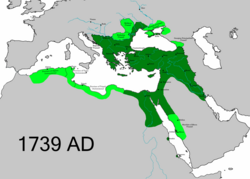
The Treaty of Küçük Kaynarca (also spelled Kuchuk Kainarji) was signed on July 21, 1774, in Küçük Kaynarca, Dobruja (today Kaynardzha, Silistra Province, Bulgaria) between the Russian Empire (represented by Field-Marshal Rumyantsev) and the Ottoman Empire after the Ottoman Empire was defeated in the Russo-Turkish War of 1768–1774. [10]
The treaty was by far the most humiliating blow to the once-mighty Ottoman realm. The Ottomans ceded the part of the Yedisan region between the Dnieper and Southern Bug rivers to Russia. This territory included the port of Kherson and gave the Russian Empire its first direct access to the Black Sea. The treaty also gave Russia the Crimean ports of Kerch and Enikale and the Kabarda region in the Caucasus.
The Ottomans also lost the Crimean Khanate, to which they were forced to grant independence. The Khanate, while nominally independent, was dependent on Russia and was formally annexed into the Russian Empire in 1783. The treaty also granted Russia several non-geographic items. It eliminated restrictions over Russian access to the Azov Sea (the 1739 Treaty of Belgrade had given Russia territory adjacent to the Azov Sea but had prohibited it from fortifying the area or using the sea for shipping.)
The Treaty of Jassy, signed at Jassy (Iaşi) in Moldavia (presently in Romania), was a pact between the Russian and Ottoman Empires ending the Russo-Turkish War of 1787–92 and confirming Russia's increasing dominance in the Black Sea. The treaty was signed on January 9, 1792 by Grand Vizier Yusuf-Pasha and Prince Bezborodko (who had succeeded Prince Potemkin as the head of the Russian delegation when Potemkin died). The treaty recognized Russia's 1783 annexation of the Crimean Khanate and transferred Yedisan to Russia making the Dniester the Russo-Turkish frontier in Europe, and leaving the Asiatic frontier (Kuban River) to the East.
Led by Napoleon Bonaparte in 1798 France invaded Egypt. While forced to leave in 1800, they had a great social impact on the country and its culture.
The Turks struggle to hold onto Egypt against a civil war between the Albanians, Mamelukes, and Turks.
The Treaty of Bucharest between the Ottoman Empire and the Russian Empire, was signed on May 28, 1812 in Bucharest at the end of the Russo-Turkish War, 1806-1812. Under its terms, the Prut River became the border between the two empires, thus leaving Bessarabia under Russian rule. Also, Russia obtained trading rights on the Danube. A truce was signed with the rebelling Serbs and autonomy given to Serbia. The treaty, signed by the Russian commander Mikhail Kutuzov, was ratified by Alexander I of Russia just one day before Napoleon launched his invasion of Russia.
| Rise of nationalism in the Balkans Nationalism under the Ottoman Empire |
|---|
The Second Serbian Uprising (1815–1817) was a second phase of the Serbian revolution against the Ottoman Empire, which erupted shortly after the re-annexation of the country to the Ottoman Empire, in 1813. The occupation was enforced following the defeat of the First Serbian Uprising (1804–1813), during which Serbia existed as a de facto independent state for over a decade. The second revolution ultimately resulted in Serbian semi-independence from the Ottoman Empire. Principality of Serbia was established, governed by its own Parliament, Constitution and its own royal dynasty. De jure independence followed during the second half of the 19th century.

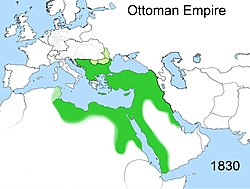
But another, more serious matter enraged the Dey. France had the commercial concession of a stockhouse in La Calle, and, by the intermediary of its representative Deval, had engaged itself not to fortify it. However, Paris did not respect its engagements. The Dey first requested explanations by sending a letter to the French government, who chose not to respond to him. Thus, the Dey orally asked the reasons behind this disrespect of their conventions to the French consul, who refused to respond to him.
The Dey responded to French disdain by hitting the consul Deval with his fan on April 30, 1827. This led to the rupture of diplomatic relations between France and the Dey, although the financial dealings between Deval and the Bacri-Busnach, as well as the Calle fortifications affairs were the real causes of the hostility.
Thereafter, the government of Charles X (1824–1830) took the "fan affair" ("l'affaire de l'éventail") as a pretext to invade Algeria and castigate the Dey for his "impudence." The French consul and residents took off for France, while the Minister of War, Clermont-Tonnerre, proposed a military expedition. The ultra-royalist Count of Villèle, President of the Council, and the monarch's heir opposed themselves to it. The Restoration finally decided to blockade Algiers for three years. But the important tonnage of French ships forced them to keep away from the coasts[ vague ], while the Barbary pilots could easily exploit the geography of the coast. Before the failure of the blockade, the Restoration decided on January 31, 1830 to engage a military expedition against Algiers.
The French troops took the advantage on June 19, during the battle of Staoueli, and entered in Algiers on July 5, 1830, after a three-week campaign. The Dey Hussein accepted capitulation in exchange of his freedom and the offer to retain possession of his personal wealth. Five days later, he exiled himself with his family, on board of a French ship heading for the Italian peninsula, then under the control of the Austrian Empire. 2,500 janissaries also quit the Algerian territories, heading for Asia, on July 11,. After 313 years of occupation, the Ottomans abandoned the Regency in Algiers and therefore the administration of the country, which they had taken care of since 1517.
The Crimean War (1853–1856) was fought between Imperial Russia on one side and an alliance of France, the United Kingdom, the Kingdom of Sardinia, and the Ottoman Empire on the other. Most of the conflict took place on the Crimean Peninsula, with additional actions occurring in western Turkey, the Baltic Sea region and Kamchatka.
The electors in both Moldavia and Wallachia chose in 1859 the same person – Alexandru Ioan Cuza.

On February 5, 1862 (January 24, Old Style) the two principalities of Moldavia and Wallachia were formally united to form Romania, with Bucharest as its capital.

Ending the Russo-Turkish War, 1877–78 the Treaty of Berlin was the final Act of the Congress of Berlin (June 13 – July 13, 1878), by which the United Kingdom, Austria-Hungary, France, Germany, Italy, Russia and the Ottoman Empire under Abdul Hamid II revised the Treaty of San Stefano signed on March 3, of the same year.
The treaty recognized the complete independence of the principalities of Romania, Serbia and Montenegro and the autonomy of Bulgaria, though the latter remained under formal Ottoman overlordship and was divided between the Principality of Bulgaria and the autonomous province of Eastern Rumelia. The Western Great Powers immediately rejected the Treaty of San Stefano: they feared that a large Slavic country in the Balkans would serve Russian interests. Most of northern Thrace was included in the autonomous region of Eastern Rumelia, whereas the rest of Thrace and all of Macedonia were returned under the sovereignty of the Ottomans.
On the other hand, between 1840-1880 period; Ottoman vassal-Khedivate of Egypt and Ottoman troops conquered Soudan,some parts of Ethiophia, Eritrea and Northern Somalia. They co-administrated these places.



With Egypt heading towards bankruptcy, the United Kingdom seized control of Egypt's government in 1882 to protect its financial interests, especially those in the Suez Canal. Shortly after its political intervention, Britain sent troops into Alexandria and the Canal Zone, taking advantage of Egypt's weak military. With the defeat of the Egyptian army at the Battle of Tel el-Kebir, British troops reached Cairo, eliminated the nationalist government and disbanded the Egyptian military. Technically, Egypt remained an Ottoman province until 1914, when Britain formally declared a protectorate over Egypt and deposed Egypt's last khedive, Abbas II. His uncle, Husayn Kamil, was appointed as Sultan in his place. But in reality Egypt and Soudan was lost to the Turks.
After that, Britain involved to Mehdis War in Soudan. In 3 years time, Ottoman Empire lost all co-administrated territories with Egypt in Africa such as North Somalia, Eritrea and Northern Ethiopia. The last only remnant Ottoman territory in Africa was "Ottoman Tripolitania."
The Young Turk revolution resulted in the loss of the Ottoman province of Bosnia-Herzegovina to Austria-Hungary, which at any rate had militarily occupied the region since 1878. Moreover, the tributary Principality of Bulgaria declared independence from the Ottoman Empire. Bulgaria simultaneously annexed the autonomous Ottoman Province of Eastern Rumelia (of which the Prince of Bulgaria had been Governor-General since 1885). Thus was Bulgaria lost to the Ottomans after more than 500 years of continuous rule.

The Italo-Turkish or Turco-Italian War (also known in Italy as guerra di Libia, "the Libyan war", and in Turkey as Trablusgarp Savaşı) was fought between the Ottoman Empire and Italy from September 29, 1911 to October 18, 1912. Italy seized the Ottoman provinces of Tripolitania and Cyrenaica, together forming what became known as Libya.There was no longer any Ottoman territory left in Africa. Following the First Balkan War, the Autonomous Principality of Samos, an Ottoman tributary state, was annexed to Greece in November 1912. See figure, right.
Italy also gained the primarily Greek-speaking Dodecanese archipelago near Anatolia, including the Isle of Rhodes. See figure, below.

The Balkan Wars were two wars in Southeast Europe in 1912–1913 in the course of which the Balkan League (Bulgaria, Montenegro, Greece, and Serbia) first conquered Ottoman-held Macedonia, Albania and most of Thrace and then fell out over the division of the spoils. In the First Balkan War, the Ottomans lost practically all of their remaining territory in Europe, with the exception of Constantinople and its immediate environs. In the Second Balkan War, they recaptured some land to the north and west up to Adrianople (Edirne), comprising modern-day East Thrace.
After the Second Balkan War, the Ottomans were removed from Albania and there was a possibility of some of the lands being absorbed by Serbia and the southern tip by Greece. This decision angered the Italians, who did not want Serbia to have an extended coastline, and it also angered the Austro-Hungarians, who did not want a powerful Serbia on their southern border. Despite Serbian, Montenegrin, and Greek occupation forces on the ground, and under immense pressure from Austria-Hungary, it was decided that the country should not be divided but instead consolidated into the Principality of Albania. In the aftermath of the Balkan wars, Crete joined Greece on December 1, 1913.
Ibn Saud completed his conquest of the Nejd and the eastern coast of Arabia in 1912 and in 1913 took Al-Hasa from Ottomans who had controlled the area since 1871.
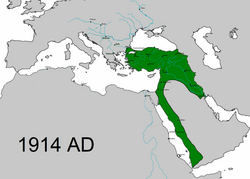
Following the Ottoman declaration of war on the Allies in November 1914, Britain formally annexed Cyprus, which it had occupied since 1878. Egypt (along with the Sudan) also finally ceased to be de jure Ottoman territory at the same time, being elevated to a Sultanate.

The Treaty of Sèvres (August 10, 1920) was the peace treaty between the Ottoman Empire and Allies at the end of World War I. The Treaty of Versailles was signed with Germany before this treaty to annul the German concessions including the economic rights and enterprises. Also, France, Great Britain and Italy signed a secret "Tripartite Agreement" at the same date. [11] The Tripartite Agreement confirmed Britain's oil and commercial concessions and turned the former German enterprises in the Ottoman Empire over to a Tripartite corporation. The open negotiations covered a period of more than fifteen months, beginning at the Paris Peace Conference. The negotiations continued at the Conference of London, and took definite shape only after the premiers' meeting at the San Remo conference in April 1920. France, Italy, and Great Britain, however, had secretly begun the partitioning of the Ottoman Empire as early as 1915. The delay was due to the fact that the powers could not come to an agreement which, in turn, hinged on the outcome of the Turkish national movement. The Treaty of Sèvres was annulled in the course of the Turkish War of Independence and the parties signed and ratified the superseding Treaty of Lausanne in 1923.
The Treaty of Lausanne (July 24, 1923) was a peace treaty signed in Lausanne, Switzerland, that settled the Anatolian and East Thracian parts of the partitioning of the Ottoman Empire by annulment of the Treaty of Sèvres (1920) that was signed by the Istanbul-based Ottoman government; as the consequence of the Turkish War of Independence between the Allies of World War I and the Ankara-based Grand National Assembly of Turkey (Turkish national movement) led by Mustafa Kemal Atatürk. [12] Several provisions of the Lausanne Treaty support the continuity between the Ottoman Empire and the Turkish Republic. [13] The Treaty of Lausanne led to the international recognition of the sovereignty of the new Republic of Turkey as the successor of the Ottoman Empire. [14] [15] [16]

The Treaty of Karlowitz, concluding the Great Turkish War of 1683–1697, in which the Ottoman Empire was defeated by the Holy League at the Battle of Zenta, was signed in Karlowitz, in the Military Frontier of the Archduchy of Austria, on 26 January 1699. Also known as "The Austrian treaty that saved Europe", it marks the end of Ottoman control in much of Central Europe, with their first major territorial losses in Europe, beginning the reversal of four centuries of expansion (1299–1683). The treaty established the Habsburg monarchy as the dominant power of the region.
The Treaty of Küçük Kaynarca, formerly often written Kuchuk-Kainarji, was a peace treaty signed on 21 July 1774, in Küçük Kaynarca between the Russian Empire and the Ottoman Empire, ending the Russo-Turkish War of 1768–74 with many concessions to Russia. The concessions to Russia are not merely territorial; not only are the territories of Romania and Crimea Khanate ceded, Russia also gains the right to construct a Greek Orthodox Church in Istanbul, claiming itself to be the protector of the Greek Orthodox Ottoman community, as a pretext for frequent and numerous interventions in the decades to follow. Ottoman Christians started to feel more empowered as European and Christian powers demonstrated their rising influence and political power. Access to Europe's political networks, markets and educational institutions created a class privilege for Ottoman Christians, and scholars often regard the treaty as turning point for relations between Ottoman Christians and the European nations.

The Russo-Turkish War of 1768–1774 was a major armed conflict that saw Russian arms largely victorious against the Ottoman Empire. Russia's victory brought the Yedisan between the rivers Bug and Dnieper, and Crimea into the Russian sphere of influence. Through a series of victories accrued by the Russian Empire led to substantial territorial conquests, including direct conquest over much of the Pontic–Caspian steppe, less Ottoman territory was directly annexed than might otherwise be expected due to a complex struggle within the European diplomatic system to maintain a balance of power that was acceptable to other European states and avoided direct Russian hegemony over Eastern Europe.

The Ottoman Empire was founded c. 1299 by Osman I as a small beylik in northwestern Asia Minor just south of the Byzantine capital Constantinople. In 1326, the Ottomans captured nearby Bursa, cutting off Asia Minor from Byzantine control. The Ottomans first crossed into Europe in 1352, establishing a permanent settlement at Çimpe Castle on the Dardanelles in 1354 and moving their capital to Edirne (Adrianople) in 1369. At the same time, the numerous small Turkic states in Asia Minor were assimilated into the budding Ottoman sultanate through conquest or declarations of allegiance.

The Russo-Turkish War (1806–1812) between the Russian Empire and the Ottoman Empire was one of the Russo-Turkish Wars. Russia prevailed, but both sides wanted peace as they feared Napoleon's moves to the east.

A series of military conflicts between the Ottoman Empire and various European states took place from the Late Middle Ages up through the early 20th century. The earliest conflicts began during the Byzantine–Ottoman wars, waged in Anatolia in the late 13th century before entering Europe in the mid-14th century with the Bulgarian–Ottoman wars. The mid-15th century saw the Serbian–Ottoman wars and the Albanian-Ottoman wars. Much of this period was characterized by Ottoman expansion into the Balkans. The Ottoman Empire made further inroads into Central Europe in the 15th and 16th centuries, culminating in the peak of Ottoman territorial claims in Europe.

The Russo-Ottoman War of 1710–1711, also known as the Pruth River Campaign, was a brief military conflict between the Tsardom of Russia and the Ottoman Empire. The main battle took place during 18-22 July 1711 in the basin of the Pruth river near Stănilești after Tsar Peter I entered the Ottoman vassal Principality of Moldavia, following the Ottoman Empire’s declaration of war on Russia. The ill-prepared 38,000 Russians with 5,000 Moldavians, found themselves surrounded by the Ottoman Army under Grand Vizier Baltacı Mehmet Pasha. After three days of fighting and heavy casualties the Tsar and his army were allowed to withdraw after agreeing to abandon the fortress of Azov and its surrounding territory. The Ottoman victory led to the Treaty of the Pruth which was confirmed by the Treaty of Adrianople.
In diplomatic history, the Eastern question was the issue of the political and economic instability in the Ottoman Empire from the late 18th to early 20th centuries and the subsequent strategic competition and political considerations of the European great powers in light of this. Characterized as the "sick man of Europe", the relative weakening of the empire's military strength in the second half of the eighteenth century threatened to undermine the fragile balance of power system largely shaped by the Concert of Europe. The Eastern question encompassed myriad interrelated elements: Ottoman military defeats, Ottoman institutional insolvency, the ongoing Ottoman political and economic modernization programme, the rise of ethno-religious nationalism in its provinces, and Great Power rivalries. In an attempt to triangulate between these various concerns, the historian Leslie Rogne Schumacher has proposed the following definition of the Eastern Question:
The "Eastern Question" refers to the events and the complex set of dynamics related to Europe's experience of and stake in the decline in political, military and economic power and regional significance of the Ottoman Empire from the latter half of the eighteenth century to the formation of modern Turkey in 1923.

The Treaty of Bucharest between the Ottoman Empire and the Russian Empire, was signed on 28 May 1812, in Manuc's Inn in Bucharest, and ratified on 5 July 1812, at the end of the Russo-Turkish War of 1806–1812. The Ottomans had done poorly in the war. The Sublime Porte above all wanted to stay out of the impending conflict between Napoleon's France and Russia. The Russians didn't want a war on two fronts, thus they made peace in order to be free for the upcoming war with France. The Ottomans had extricated themselves from a potentially disastrous war with a slight loss of territory. This treaty became the basis for future Russo-Ottoman relations.

The Danubian Principalities was a conventional name given to the Principalities of Moldavia and Wallachia, which emerged in the early 14th century. The term was coined in the Habsburg monarchy after the Treaty of Küçük Kaynarca (1774) in order to designate an area on the lower Danube with a common geopolitical situation. The term was largely used then by foreign political circles and public opinion until the union of the two principalities in 1859. Alongside Transylvania, the United Principalities of Moldavia and Wallachia became the basis for the Kingdom of Romania, and by extension the modern nation-state of Romania.

The Classical Age of the Ottoman Empire concerns the history of the Ottoman Empire from the conquest of Constantinople in 1453 until the second half of the sixteenth century, roughly the end of the reign of Suleiman the Magnificent. During this period a system of patrimonial rule based on the absolute authority of the sultan reached its apex, and the empire developed the institutional foundations which it would maintain, in modified form, for several centuries. The territory of the Ottoman Empire greatly expanded, and led to what some historians have called the Pax Ottomana. The process of centralization undergone by the empire prior to 1453 was brought to completion in the reign of Mehmed II.

The majority of what is now the Republic of Serbia was incorporated in the Ottoman Empire from the mid 15th century until the early 19th century. From the early 18th century, Vojvodina was no longer incorporated in the empire as it was ceded to the Habsburgs.

Russo-Turkish wars or Russo-Ottoman wars were a series of twelve wars fought between the Russian Empire and the Ottoman Empire between the 16th and 20th centuries. It was one of the longest series of military conflicts in European history. Except for the war of 1710–11, as well as the Crimean War which is often treated as a separate event, the conflicts ended disastrously for the Ottoman Empire, which was undergoing a long period of stagnation and decline; conversely, they showcased the ascendancy of Russia as a European power after the modernization efforts of Peter the Great in the early 18th century.

The foreign relations of the Ottoman Empire were characterized by competition with the Persian Empire to the east, Russia to the north, and Austria to the west. The control over European minorities began to collapse after 1800, with Greece being the first to break free, followed by Serbia. Egypt was lost in 1798–1805. In the early 20th century Austria-Hungary annexed Bosnia and Herzegovina, the Bulgarian Declaration of Independence soon followed. The Ottomans lost nearly all their European territory in the First Balkan War (1912–1913). The Ottoman Empire allied itself with the Central Powers in the First World War, and lost. The British successfully mobilized Arab nationalism. The Ottoman Empire thereby lost its Arab possessions, and itself soon collapsed in the early 1920s. For the period after 1923 see Foreign relations of Turkey.

The Polish-Ottoman Wars were a series of conflicts that took place between the Polish-Lithuanian Commonwealth and the Ottoman Empire during the 16th and 17th centuries. These wars were part of the broader struggle for dominance in Eastern Europe between Christian and Muslim powers. The conflicts involved territorial disputes, religious differences, and power struggles in the region.

The Ottoman–Habsburg wars were fought from the 16th to the 18th centuries between the Ottoman Empire and the Habsburg monarchy, which was at times supported by the Kingdom of Hungary, Polish–Lithuanian Commonwealth, and Habsburg Spain. The wars were dominated by land campaigns in Hungary, including Transylvania and Vojvodina, Croatia, and central Serbia.

The Austro-Turkish War was fought in 1788–1791 between the Habsburg monarchy and the Ottoman Empire, concomitantly with the Russo-Turkish War (1787–1792), Russo-Swedish War (1788–1790) and Theatre War. It is sometimes referred to as the Habsburg–Ottoman War or the Austro-Ottoman War.

The Ottoman–Hungarian Wars were a series of battles between the Ottoman Empire and the medieval Kingdom of Hungary. Following the Byzantine Civil War, the Ottoman capture of Gallipoli, and the decisive Battle of Kosovo, the Ottoman Empire was poised to conquer the entirety of the Balkans and also sought and expressed desire to expand further north into Central Europe beginning with the Hungarian lands.
{{citation}}: CS1 maint: location missing publisher (link)